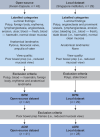Development and validation of a deep learning system for detection of small bowel pathologies in capsule endoscopy: a pilot study in a Singapore institution
- PMID: 38527297
- PMCID: PMC11060635
- DOI: 10.4103/singaporemedj.SMJ-2023-187
Development and validation of a deep learning system for detection of small bowel pathologies in capsule endoscopy: a pilot study in a Singapore institution
Abstract
Introduction: Deep learning models can assess the quality of images and discriminate among abnormalities in small bowel capsule endoscopy (CE), reducing fatigue and the time needed for diagnosis. They serve as a decision support system, partially automating the diagnosis process by providing probability predictions for abnormalities.
Methods: We demonstrated the use of deep learning models in CE image analysis, specifically by piloting a bowel preparation model (BPM) and an abnormality detection model (ADM) to determine frame-level view quality and the presence of abnormal findings, respectively. We used convolutional neural network-based models pretrained on large-scale open-domain data to extract spatial features of CE images that were then used in a dense feed-forward neural network classifier. We then combined the open-source Kvasir-Capsule dataset (n = 43) and locally collected CE data (n = 29).
Results: Model performance was compared using averaged five-fold and two-fold cross-validation for BPMs and ADMs, respectively. The best BPM model based on a pre-trained ResNet50 architecture had an area under the receiver operating characteristic and precision-recall curves of 0.969±0.008 and 0.843±0.041, respectively. The best ADM model, also based on ResNet50, had top-1 and top-2 accuracies of 84.03±0.051 and 94.78±0.028, respectively. The models could process approximately 200-250 images per second and showed good discrimination on time-critical abnormalities such as bleeding.
Conclusion: Our pilot models showed the potential to improve time to diagnosis in CE workflows. To our knowledge, our approach is unique to the Singapore context. The value of our work can be further evaluated in a pragmatic manner that is sensitive to existing clinician workflow and resource constraints.
Copyright © 2024 Copyright: © 2024 Singapore Medical Journal.
Conflict of interest statement
There are no conflicts of interest.
Figures







References
-
- Cheung DY, Lee IS, Chang DK, Kim JO, Cheon JH, Jang BI, et al. Capsule endoscopy in small bowel tumors: A multicenter Korean study. J Gastroenterol Hepatol. 2010;25:1079–86. - PubMed
-
- Leong AFPK. Wireless capsule endoscopy: Light at the end of the tunnel for obscure gastrointestinal bleeding. Singapore Med J. 2003;44:496–7. - PubMed
MeSH terms
LinkOut - more resources
Full Text Sources
Research Materials
Miscellaneous

